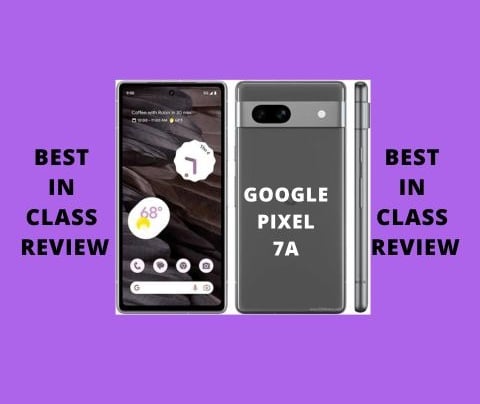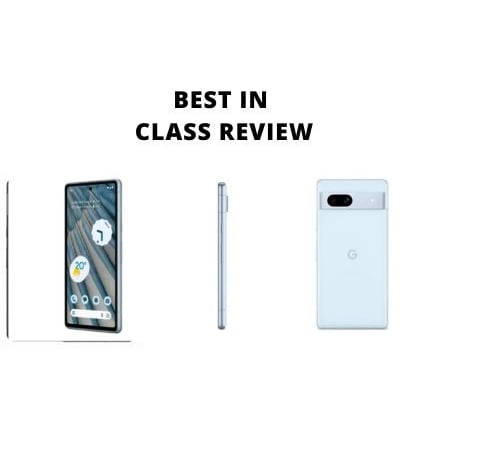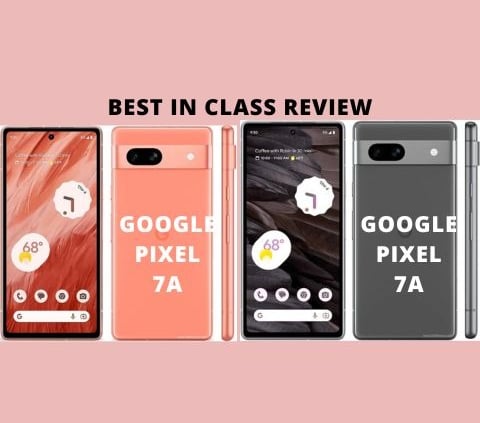Add your promotional text...
In-Depth Review of Google Pixel 7a Features
Explore the Google Pixel 7a in-depth with our comprehensive review. Discover its impressive AI-powered camera, smooth performance, and affordable price, while also considering its plastic build and limited battery life. Make an informed decision before buying!
GOOGLE PIXEL
2/26/202522 min read
Google Pixel 7a Review
Google Pixel 7a Review: The Affordable Flagship You’ve Been Waiting For
The Google Pixel 7a is the latest addition to Google’s Pixel lineup, offering an impressive blend of premium features and affordability. Aimed at those who want the Pixel experience without breaking the bank, the Pixel 7a comes with a sleek design, excellent camera capabilities, and the seamless Android experience that we’ve come to expect from Google.
But, as with any device, it’s important to weigh both the strengths and weaknesses before diving in. In this review, we’ll take a closer look at what makes the Pixel 7a stand out, including its camera performance, display quality, and overall value for money. We’ll also talk about where it might fall short, particularly in areas like design and performance compared to its more expensive counterparts.
Strengths of the Pixel 7a:
Fantastic Camera: Google's AI-driven camera software continues to impress, offering features like Night Sight and Magic Eraser, making it one of the best budget-friendly camera phones out there.
Clean Android Experience: With Google’s Pixel UI, you get a pure, bloat-free Android experience with regular software updates, ensuring longevity and security.
Value for Money: Packed with flagship-like features, the Pixel 7a offers excellent value, especially considering its price point.
Weaknesses to Consider:
Battery Life: While decent, the battery life isn’t as robust as some competitors in its price range.
Plastic Build: While the plastic back helps keep costs down, it doesn’t feel as premium as glass or metal-bodied devices.
Limited Performance: It’s a capable device, but heavy gamers or users requiring high-end performance might find it lacking compared to higher-tier models.
Key Competitors:
The Pixel 7a is in direct competition with several other budget-friendly smartphones, including the Apple iPhone SE (2022), which offers a similar price point with the iOS ecosystem, and the Samsung Galaxy A54 5G, which boasts a large display and strong battery life. Additionally, phones like the OnePlus Nord 3 and Samsung Galaxy A34 are also vying for the attention of those seeking a great value phone.
Let’s dive deeper into each of these aspects and see if the Pixel 7a is truly the best option in this price range!
Introduction


Key Features of the Google Pixel 7a: An In-Depth Review
The Google Pixel 7a is a standout in the budget-friendly smartphone market, offering an array of impressive features typically found in more expensive models. Whether you're a tech enthusiast or someone simply looking for a reliable, high-performance phone without the hefty price tag, the Pixel 7a provides an exceptional balance of features. Let’s dive into the standout features that make the Pixel 7a a worthy contender in the budget smartphone category.
1. Impressive 64MP Dual-Camera System
One of the most enticing features of the Google Pixel 7a is its camera system. With a 64MP main sensor and a 13MP ultra-wide lens, the Pixel 7a takes stunning photos that rival those of flagship devices. Google's AI-powered software enhances the overall photo experience, making it incredibly easy for users to snap beautiful shots with minimal effort.
Key Camera Features:
Magic Eraser: Remove unwanted elements from your photos with just a tap.
Night Sight: Capture sharp and clear photos even in low-light environments, delivering excellent performance in night photography.
Real Tone: Ensures that skin tones are accurately represented, making every photo look more natural and true to life.
The camera setup also benefits from Google’s computational photography, ensuring consistent results in various lighting conditions. For those who value a top-tier camera experience, the Pixel 7a delivers far more than you'd expect at its price point.
2. Smooth 90Hz OLED Display
The 6.1-inch OLED display on the Pixel 7a provides vibrant colors, deep blacks, and overall sharpness that elevate the viewing experience. With a 90Hz refresh rate, everything from scrolling to gaming feels incredibly smooth, enhancing the overall fluidity of the device. This display quality is not only impressive for a budget phone but rivals that of mid-range and flagship devices.
Whether you're watching videos, browsing social media, or playing casual games, the Pixel 7a offers an immersive and smooth display experience. Plus, HDR support ensures that video content appears rich in detail, making it a joy for entertainment on the go.
3. Google Tensor G2 Chip: Performance That Delivers
Under the hood, the Google Tensor G2 chip powers the Pixel 7a. This custom-built processor enables lightning-fast performance and enhanced AI capabilities. Whether you're multitasking, browsing, or running apps, the Pixel 7a delivers a smooth experience.
Key Advantages of the Tensor G2:
Efficient AI and Machine Learning: Google's Tensor chip enhances photography, voice recognition, and overall device performance by integrating powerful AI capabilities.
Better Optimization: The Tensor chip is finely tuned to work seamlessly with Android, ensuring efficient power management and quick app launches.
Future-Proof Performance: Though not as powerful as flagship processors, the Tensor G2 ensures that the Pixel 7a can handle day-to-day tasks with ease, while providing long-term software support through Google’s frequent updates.
For those looking for a balanced device in terms of power and efficiency, the Tensor G2 chip offers great value without going overboard on price.
4. Long-Lasting Battery with Fast Charging
The Pixel 7a comes equipped with a 4385mAh battery, offering all-day battery life under normal usage. While it may not offer the industry-leading longevity of some competitors, it's more than enough to get you through a busy day of texting, calling, browsing, and light gaming.
Additionally, the 18W fast charging support means you won’t be waiting long to get your phone back to full power. While not as fast as some other devices in the market, it’s a nice touch for those who are always on the move and need a quick power boost.
5. Clean Android Experience with Regular Updates
One of the major draws of the Google Pixel 7a is its clean, bloat-free Android experience. As a Pixel device, it runs stock Android—which means no unnecessary apps or custom skins to slow things down. The interface is simple, intuitive, and user-friendly, with a design that’s as functional as it is sleek.
Furthermore, being a Google device, the Pixel 7a enjoys exclusive features such as:
Google Assistant Integration: Easily access Google’s voice assistant with the press of a button or voice command.
Security Updates: Enjoy three years of OS upgrades and five years of security updates, ensuring that the Pixel 7a stays secure and functional long-term.
Exclusive Features for Pixel Devices:
Call Screening: Google’s smart call-screening feature filters out spam calls, keeping your phone calls more peaceful.
Live Translate: Break down language barriers in real-time, translating conversations in over 40 languages directly within the app.
This focus on timely updates and seamless software integration makes the Pixel 7a a reliable choice for Android purists who want the latest features without delays.
6. Sleek and Lightweight Design
The Google Pixel 7a has a sleek design, with a polycarbonate (plastic) body that helps keep the cost down. Despite being made from plastic, the phone still feels premium in hand due to its smooth matte finish and solid build quality. It’s lightweight and compact, making it easy to carry and use with one hand.
Design Highlights:
IP67 Water and Dust Resistance: With an IP67 rating, the Pixel 7a is protected against dust and can withstand being submerged in up to one meter of water for 30 minutes, making it more durable than most budget phones.
Fingerprint Sensor: Located under the display, the in-display fingerprint sensor is quick and responsive for easy unlocking.
7. 5G Connectivity
The 5G support in the Pixel 7a ensures that you're ready for the next-generation network speeds, allowing you to enjoy faster downloads, smoother streaming, and a better overall mobile internet experience. It supports both Sub-6 and mmWave 5G, ensuring solid connectivity wherever 5G networks are available.
This means the Pixel 7a is future-proof when it comes to mobile internet, offering a robust 5G experience at a competitive price point.
Conclusion: Why the Google Pixel 7a is a Smart Buy
In conclusion, the Google Pixel 7a excels in offering high-quality features like an impressive camera, smooth display, powerful performance, and a clean Android experience—all at an affordable price point. While it may not be perfect in every area, its overall value is hard to beat in the budget smartphone market.
Whether you're into photography, gaming, or simply need a reliable daily driver, the Pixel 7a offers a fantastic balance of features and affordability. If you’re looking for a phone that provides top-tier features without breaking the bank, the Google Pixel 7a is definitely a smart buy.
Key Features
Key Features Table
The Google Pixel 7a offers a balanced yet impressive performance thanks to the Google Tensor G2 chip, a custom-designed processor that powers its AI-driven features. The Tensor G2 brings substantial improvements in computational photography and machine learning, offering seamless image processing for the camera system, especially with features like Night Sight and Super Res Zoom. When combined with 8GB of RAM, the device performs well in multitasking scenarios, including handling apps, media consumption, and light to moderate gaming without noticeable lag or stutter. The Android 13( upgradable to future version) experience is clean, with Google’s software optimizations ensuring smooth system performance and long-term software support.
However, when it comes to raw processing power, the Pixel 7a falls short of some high-end competitors. While the Tensor G2 chip excels in AI tasks and camera performance, it’s not quite as powerful as Qualcomm Snapdragon 8 Gen 2 or Apple’s A16 Bionic in demanding tasks, such as intensive gaming or video editing. The Adreno 730 GPU in the Pixel 7a, while adequate for casual gaming, struggles to handle graphics-heavy games or resource-demanding applications with the same level of fluidity as flagship models, with frame drops occurring in certain high-performance scenarios.
Another aspect where the Pixel 7a shows room for improvement is its display. The 6.1-inch OLED panel, while vibrant, is capped at a 90Hz refresh rate, which might feel slightly outdated compared to flagship competitors that offer 120Hz or higher refresh rates for smoother scrolling and gaming. This limitation is noticeable during fast-paced tasks or when switching between apps, where users might feel the difference in fluidity.
Battery life on the Pixel 7a is commendable, with its 4385mAh battery easily lasting through a full day of moderate use. However, under heavy usage, such as extended video streaming or gaming, battery drain becomes more apparent. The 18W fast charging is decent, though not particularly fast by today’s standards, as it lags behind the competition’s 30W+ fast charging speeds.
In summary, while the Google Pixel 7a excels in everyday performance, camera capabilities, and AI-driven tasks, its gaming and intensive use performance does not match that of higher-end flagships. The Tensor G2 chip, while competent, still falls behind in raw processing power, and the display’s refresh rate is a missed opportunity for users looking for a high-end experience. Nonetheless, for most typical users, the Pixel 7a offers a very well-rounded performance at a more accessible price point.
Performance Analysis


The Google Pixel 7a is strategically positioned in the mid-range smartphone market, targeting consumers who want premium features, particularly in camera performance and software experience, without the premium price tag. Positioned between Google's flagship Pixel 7 Pro and the more affordable Pixel 6a, the Pixel 7a offers a compelling value proposition with its Tensor G2 chip, AI-driven features, and a strong focus on camera performance, especially for users who prioritize computational photography. Its 6.1-inch OLED display, 5G connectivity, and stock Android experience further strengthen its appeal to those seeking a reliable, high-quality device at a more accessible price point. The inclusion of long-term software updates and security features adds to its value, making it particularly attractive to users who value longevity and timely software support.
However, the Pixel 7a's market positioning also presents certain weaknesses. Its 90Hz refresh rate display and lack of flagship-level performance, particularly in gaming and intensive tasks, may limit its appeal to power users or those accustomed to high-end smartphones with smoother screens and faster processing power. Additionally, while it competes well in terms of camera performance, its mid-range price point places it in direct competition with devices like the Samsung Galaxy A54 or the OnePlus Nord 3, which offer similar features and performance at comparable or sometimes lower prices. Google's brand recognition in the budget and mid-range category is still growing, as it faces stiff competition from well-established players like Apple’s iPhone SE and Samsung’s A-series, making it harder to secure a larger share of the market. Despite this, the Pixel 7a's blend of premium features and affordable pricing allows it to carve out a strong niche, offering a compelling alternative to higher-priced competitors, though it must continue to innovate to remain competitive in a crowded market.
Market Positioning
Pros and Cons of the Google Pixel 7a: A Comprehensive Review
The Google Pixel 7a is one of the most anticipated mid-range smartphones in 2023, offering a balance of impressive features and affordability. But how does it really stack up? Let’s dive into the pros and cons to give you a clear idea of what this device brings to the table.
Pros of the Google Pixel 7a
1. Impressive Camera Performance
One of the standout features of the Google Pixel 7a is its camera system. The 64MP main sensor paired with a 13MP ultra-wide lens ensures stunning photos across a variety of conditions. Google’s advanced computational photography, powered by the Tensor G2 chip, enhances image quality with features like Night Sight for low-light shots, Super Res Zoom for high-quality zoomed images, and Real Tone for accurate skin tones. For those who prioritize mobile photography, the Pixel 7a delivers flagship-level camera performance at a more affordable price.
2. Excellent Software Experience
As with all Pixel devices, the Pixel 7a offers an exceptional stock Android experience. The phone comes with Android 13 ( upgradable to future version), providing a clean interface without bloatware and offering a seamless and smooth user experience. Additionally, the device is guaranteed 3 years of software updates and 5 years of security patches, ensuring that you’ll receive timely updates and enjoy the latest Android features for years to come.
3. Google’s Custom Tensor G2 Chip
The Tensor G2 chip in the Pixel 7a might not rival the most powerful flagship processors, but it brings exceptional performance for the price. Its AI capabilities significantly improve speech recognition, camera processing, and on-device machine learning. The Pixel 7a is smooth for everyday tasks like browsing, social media, video streaming, and light gaming, making it an all-around solid performer for most users.
4. Long-Lasting Battery Life
The 4385mAh battery on the Pixel 7a can easily last a full day with moderate use. This includes activities like browsing, texting, watching videos, and using social media. While it may not last as long as some competitors with larger batteries, it still delivers dependable battery life for users who aren’t constantly on their devices. Plus, with 18W fast charging, you can quickly juice up your phone when needed.
5. Clean and Elegant Design
The Google Pixel 7a boasts a sleek, minimalist design with a 6.1-inch OLED display that offers vibrant colors and deep blacks. The phone is lightweight and comfortable to hold, making it ideal for users who prefer compact devices. It also comes in a variety of attractive colors, giving it a modern and stylish look.
Cons of the Google Pixel 7a
1. Limited Display Refresh Rate
While the 6.1-inch OLED display on the Pixel 7a looks good, it’s limited to a 90Hz refresh rate. This is a noticeable downside when compared to flagship devices or even some mid-range competitors like the Samsung Galaxy A54, which offers a 120Hz refresh rate for smoother scrolling and gaming. Users who are accustomed to higher refresh rates may find the Pixel 7a’s display less responsive, especially when scrolling through content or playing fast-paced games.
2. No Telephoto Lens
While the Pixel 7a’s camera system is excellent for general photography, it lacks a telephoto lens for more detailed zoomed-in shots. Competitors like the iPhone SE (2022) and Samsung Galaxy A54 may offer a more versatile zoom range with additional lenses, so if you’re someone who regularly needs to zoom in for more detailed photos, this could be a limitation.
3. No Wireless Charging
Another feature missing from the Pixel 7a is wireless charging. Many other smartphones in the mid-range segment now come with wireless charging support, which is a convenient way to top off your battery without plugging in cables. While this might not be a dealbreaker for everyone, it is a feature that many users have come to appreciate in recent years.
4. Gaming Performance Could Be Better
While the Tensor G2 chip offers solid performance for most tasks, it falls short when it comes to intensive gaming. The phone struggles to maintain consistent frame rates during graphics-heavy games, which could be a dealbreaker for gamers who demand smooth performance. If gaming is a top priority for you, devices with more powerful processors like the Snapdragon 8 Gen 1 might be a better choice.
5. Slower Charging Speed
Although the Pixel 7a supports 18W fast charging, this is relatively slow compared to some of its competitors, which offer 30W or faster charging speeds. This can be a disadvantage if you're someone who needs to quickly charge your device on the go. While the battery life is solid, the slower charging time can feel inconvenient for users in a rush.
Conclusion
The Google Pixel 7a is a fantastic choice for anyone seeking a well-rounded, affordable smartphone that excels in camera quality, software experience, and battery life. It’s a perfect option for users who prioritize Android updates and AI-driven features like improved photography and Google Assistant capabilities. However, the device does have some limitations, including the 90Hz display refresh rate, the lack of a telephoto lens, and slower charging speeds. Despite these drawbacks, the Pixel 7a offers exceptional value in the mid-range category, making it an attractive option for users looking for premium features without the premium price tag.
Prons and Cons


Comparative Analysis: Google Pixel 7a vs Key Competitors
The Google Pixel 7a has quickly become one of the most popular mid-range smartphones in 2023, offering great value with its impressive camera system, clean Android experience, and Google’s custom Tensor G2 chip. However, it faces stiff competition from other mid-range smartphones like the Samsung Galaxy A54, Apple iPhone SE (2022), and OnePlus Nord 3. To help you make an informed decision, let’s compare these devices in terms of features, performance, and value.
Key Competitors:
Samsung Galaxy A54
Apple iPhone SE (2022)
OnePlus Nord 3
Strengths and Weaknesses Comparison of Competitors
1. Google Pixel 7a
Strengths:
Exceptional Camera Performance: The 64MP primary camera and 13MP ultra-wide lens with Google’s computational photography make the Pixel 7a a top contender for mobile photography in the mid-range category.
Software Experience: With Android 13 ( upgradable to future version) and the guarantee of 3 years of software updates and 5 years of security patches, the Pixel 7a provides long-term support that few competitors can match.
Google’s Custom Tensor G2: The Tensor G2 chip enhances AI-driven features like speech recognition, camera improvements, and overall system optimization, delivering a fluid experience for everyday tasks.
Clean, Stock Android: No bloatware, with access to exclusive Google features like Google Assistant and Google Lens.
Weaknesses:
90Hz Display: The 6.1-inch OLED screen is vibrant, but the lack of a higher refresh rate (120Hz) means it falls behind competitors like the Samsung Galaxy A54.
No Telephoto Lens: Unlike some competitors, the Pixel 7a lacks a telephoto lens, limiting its zoom capabilities.
No Wireless Charging: Many of its competitors now include wireless charging, a feature missing from the Pixel 7a.
2. Samsung Galaxy A54
Strengths:
120Hz Super AMOLED Display: The A54 features a 120Hz refresh rate, making scrolling and gaming smoother compared to the Pixel 7a’s 90Hz display.
Versatile Camera System: The 50MP wide sensor paired with an ultra-wide camera and a macro lens gives the Galaxy A54 flexibility for various photography styles.
Larger Battery: The 5000mAh battery offers better endurance, especially with its power-efficient Exynos 1380 chip.
Weaknesses:
Exynos 1380 Chip: While capable, the Exynos 1380 doesn’t offer the same performance as the Google Tensor G2 or Apple A15 Bionic, particularly in AI tasks or intensive applications.
Slower Software Updates: Samsung offers 3 years of Android updates, but the Pixel 7a gets faster and more consistent updates due to Google’s direct control over Android updates.
Bloatware: Samsung’s One UI skin, while feature-rich, contains more pre-installed apps that may not be needed by all users.
3. Apple iPhone SE (2022)
Strengths:
Apple A15 Bionic Chip: The A15 Bionic is a powerful chip that delivers high performance in gaming, multitasking, and photography, outpacing many mid-range competitors in raw power.
Compact Design: The iPhone SE offers a compact, 4.7-inch Retina HD display, making it perfect for users who prefer smaller devices.
Long-Term Software Support: Apple is known for supporting devices for many years, and the iPhone SE (2022) benefits from iOS updates for 5+ years.
Weaknesses:
Small Display: The 4.7-inch display feels outdated and cramped compared to larger-screen competitors like the Pixel 7a and Galaxy A54.
Camera Limitations: The 12MP single-lens camera on the SE lacks the versatility of competitors with multiple sensors and computational photography features.
No Face ID: Unlike most modern iPhones, the SE retains Touch ID, which may feel less secure or outdated for some users.
4. OnePlus Nord 3
Strengths:
Fast Charging: The 80W fast charging on the OnePlus Nord 3 is one of the fastest in its class, providing a full charge in just 30 minutes—far quicker than the Pixel 7a's 18W charging.
120Hz AMOLED Display: The 6.74-inch AMOLED screen with 120Hz refresh rate ensures smoother scrolling and gaming, which is a significant advantage over the Pixel 7a’s 90Hz display.
Powerful Performance: The MediaTek Dimensity 9000 chipset delivers exceptional performance in gaming, multitasking, and overall use, even outpacing the Tensor G2 in certain scenarios.
Weaknesses:
Software Experience: While OxygenOS is one of the better Android skins, it doesn’t offer the clean, bloat-free experience that stock Android provides, like on the Pixel 7a.
Camera System: The 50MP primary camera on the Nord 3 is good, but it lacks the advanced computational photography that the Pixel 7a excels at, making it less versatile in certain lighting conditions.
No IP Rating: Unlike the Pixel 7a, the OnePlus Nord 3 doesn’t have an official IP rating for water or dust resistance.
Conclusion
The Google Pixel 7a stands out in terms of software experience and camera performance but faces stiff competition from devices like the Samsung Galaxy A54 with its smooth 120Hz display, the Apple iPhone SE (2022) with its powerful A15 Bionic chip, and the OnePlus Nord 3 with its fast charging and powerful performance. While the Pixel 7a excels in AI-driven features and camera quality, it does lag behind in areas like gaming performance, refresh rate, and charging speed compared to its rivals. For users seeking a pure Android experience, long-term software support, and advanced photography capabilities, the Google Pixel 7a is a fantastic choice. However, if gaming, fast charging, or a high-refresh display are more important to you, exploring competitors like the OnePlus Nord 3 or Samsung Galaxy A54 may be worth considering.
Comparative Analysis
Features Comparison Table
The user experience on the Google Pixel 7a is designed to offer simplicity, convenience, and efficiency, making it a joy to use for both newcomers to Android and seasoned users. Right out of the box, the phone’s interface is clean and clutter-free thanks to stock Android, offering a more streamlined experience compared to heavily customized Android skins found on other devices. This means you get a bloat-free environment, which not only feels faster but also makes navigation a breeze. Google’s Material You design adds a nice touch to the system, with themes that adapt to your wallpaper, giving the interface a personalized look that’s both attractive and functional.
When it comes to performance, the Tensor G2 chip provides a smooth experience, especially in everyday tasks like social media, web browsing, and media consumption. Whether you're typing messages, multitasking, or switching between apps, the Pixel 7a’s 8GB of RAM ensures responsiveness and minimizes lag. The AI-driven features of the Tensor G2 chip are another highlight, helping the phone perform tasks like real-time language translation, smart photo enhancements, and voice recognition with impressive accuracy. It feels like having a personal assistant at your fingertips, making your daily interactions with the phone feel seamless and intuitive.
The camera app is another aspect where the Pixel 7a shines, offering a quick, responsive, and user-friendly interface. With features like Night Sight for low-light conditions and Magic Eraser for quick photo edits, you can effortlessly snap high-quality photos and make quick adjustments on the go. The photography experience is further enhanced by the computational photography features powered by the Tensor chip, making it easy to take professional-looking shots without needing to tweak settings manually.
While the 6.1-inch OLED display is vibrant and sharp, it’s a bit more limited when compared to devices with a 120Hz refresh rate, such as the Samsung Galaxy A54. This might result in a slightly less smooth scrolling experience, particularly when navigating through content-heavy apps or while gaming. But for most everyday use, the screen is more than sufficient and looks beautiful, delivering crisp visuals and deep blacks that are perfect for watching videos or viewing images.
The battery life is another solid point in the Pixel 7a’s favor, with its 4385mAh battery comfortably getting you through a full day of use. Whether you're on a Zoom call, streaming a few episodes of your favorite show, or chatting with friends, the phone can keep up with all your daily tasks without requiring frequent recharges. When it's time to recharge, the 18W fast charging ensures that you can get your phone back to full power relatively quickly, although it's not as fast as some competitors that offer 30W+ charging speeds.
In terms of software support, Google’s commitment to updates makes the Pixel 7a a great choice for users who want their phone to stay current for years. With 3 years of Android updates and 5 years of security patches, this device is built to stay secure and up-to-date long after its release, which is a big plus for those who plan on holding onto their phone for a while.
Overall, the Google Pixel 7a delivers an exceptionally user-friendly experience with a clean design, powerful AI features, and excellent camera capabilities. It’s a device that excels at simplifying your daily digital life while offering just the right amount of performance for everyday tasks. Although it may lack a higher refresh rate or advanced features like wireless charging, its balance of price and performance makes it a standout option for users who want a solid, no-frills smartphone experience.
User Experience
The Google Pixel 7a offers great value for those seeking a high-quality smartphone without the hefty price tag of flagship models. With a starting price of around $499 for the base model with 128GB of storage, it positions itself as a highly competitive option in the mid-range market. For users who need more storage, the 256GB model is available for a slightly higher price, typically around $549. This pricing makes the Pixel 7a more affordable than many of its competitors, such as the Samsung Galaxy A54 and the iPhone SE (2022), both of which are priced similarly but offer different features and performance levels. The Pixel 7a is particularly appealing for users looking for a smartphone that offers a premium camera experience, stock Android, and Google’s advanced AI features at a more accessible price point. When compared to other mid-range smartphones with similar specs, such as the OnePlus Nord 3 or the Samsung Galaxy A54, the Pixel 7a delivers excellent value for money, especially considering its long-term software support and clean user interface. Whether you’re upgrading from an older device or looking for your first smartphone, the Pixel 7a offers solid performance and premium features at an attractive price, making it a strong contender in the market for budget-conscious consumers.
Price Range


The Google Pixel 7a marks a notable evolution from its predecessors, bringing key improvements in both design and performance that elevate the overall experience. Compared to the Pixel 6a, the Pixel 7a offers a sleeker, more refined design with a slightly more premium feel, thanks to its aluminum frame and smooth, matte finish. The camera system has seen significant upgrades as well, with the 64MP primary sensor and 13MP ultra-wide lens, offering better photo quality, especially in low-light conditions, thanks to the improved computational photography features powered by the Tensor G2 chip. This marks a big leap forward from the 12.2MP camera on the Pixel 6a, offering more detailed and vibrant shots, particularly with features like Magic Eraser and Night Sight for nighttime photography. In terms of performance, the Tensor G2 chip offers faster and more efficient processing than the Tensor chip in the Pixel 6a, leading to smoother multitasking and more responsive AI features. Battery life has also improved slightly, with the Pixel 7a offering a 4385mAh battery, which provides more endurance than the 4410mAh battery in the Pixel 6a, coupled with better overall efficiency. In addition, the 120Hz display refresh rate seen in some competitors didn’t make it to the Pixel 6a, but the Pixel 7a does introduce a smooth OLED display, offering a great balance of vibrant colors and clarity, though it still remains at 60Hz. While the Pixel 7a doesn’t completely reinvent the wheel, it brings a solid refinement of what was already a great mid-range device, making it an even more compelling option for users looking for top-tier camera performance, stock Android, and advanced AI-driven features in an affordable package.
Evolution from Previous Models
When considering the Google Pixel 7a, several key decision-making factors come into play that can help determine if this phone is the right choice for you. Camera quality is a standout feature, especially for users who prioritize photography. The 64MP primary camera paired with a 13MP ultra-wide lens and advanced computational photography tools like Night Sight, Magic Eraser, and Real Tone delivers stunning images with rich colors, sharp details, and accurate skin tones. Whether you're capturing portraits, landscapes, or low-light shots, the Pixel 7a excels in producing high-quality results without the need for professional knowledge.
Another major factor is the software experience. The Pixel 7a runs stock Android 13 ( upgradable to future version), providing a simple, bloat-free interface that feels incredibly smooth and user-friendly. Google’s approach to Android is unique, with timely software updates, 3 years of Android version updates, and 5 years of security patches, making it a future-proof device. For those who enjoy a clean, intuitive user interface without pre-installed apps and unnecessary distractions, this is a key advantage.
Performance-wise, the Tensor G2 chip offers a solid boost in processing power, particularly for AI-driven tasks like real-time translations, voice recognition, and enhancing photos. The 8GB of RAM ensures smooth multitasking, whether you’re switching between apps, gaming, or browsing, while the battery life—though not the largest in its class at 4385mAh—is more than enough to get you through a full day of moderate use. While it doesn’t offer ultra-fast charging speeds compared to some competitors, the 18W fast charging is sufficient for daily needs.
Display quality is another important factor, and while the 6.1-inch OLED screen provides vibrant colors and deep blacks, it is capped at 90Hz refresh rate. This means it’s not as smooth as some higher-end competitors that offer 120Hz displays, but for most users, the experience is still enjoyable and responsive, especially for general tasks like browsing and video streaming. If you’re not particularly focused on gaming or high-refresh rate content, the display quality of the Pixel 7a should still satisfy most.
One of the defining aspects of the Pixel 7a is its affordability, with the starting price around $499 for the 128GB model. In comparison to flagship phones and even some of its competitors in the mid-range category, it offers strong value without sacrificing essential features like camera performance, AI capabilities, and software support. When you factor in the cost, the Pixel 7a becomes an excellent option for users looking for premium features at a more accessible price point.
Finally, the build quality is solid and compact, making it easy to handle with one hand. However, it lacks some premium features like wireless charging or a higher refresh rate screen, which may be a dealbreaker for users who prioritize those aspects. The Google Pixel 7a is a great all-around device for anyone who values a clean Android experience, great photography, reliable performance, and long-term support, all at an attractive price point.
So, when making your decision, consider what matters most to you—whether it's a stellar camera, smooth software, long-term updates, or a balanced performance. For those seeking a well-rounded, budget-friendly phone that punches above its weight, the Pixel 7a is an excellent choice.
Key Decision-Making Factors


In conclusion, the Google Pixel 7a is a standout mid-range smartphone that delivers exceptional value for money without compromising on performance or features. With its 64MP camera, powered by Google’s Tensor G2 chip, users can enjoy high-quality photography and seamless performance across daily tasks. The clean Android experience ensures a bloat-free interface, offering smooth navigation and long-term software updates, which is a huge advantage over other phones in this price range. While the 60Hz display may not match the 120Hz refresh rate seen in some competitors, the OLED screen still provides vibrant colors and sharp visuals, making it a great choice for most users. In terms of market positioning, the Pixel 7a sits comfortably in the budget-friendly smartphone category, competing with models like the Samsung Galaxy A54 and the OnePlus Nord. With a price tag around $499, it offers an affordable alternative to higher-end phones, making it accessible for those looking for premium features without breaking the bank. Though it lacks wireless charging and has a slightly lower refresh rate, its camera performance, AI capabilities, and long-term software support are standout features that make it a top contender in the market. Technological advancements from previous models, including the Tensor G2 chip, enhance overall performance and photography capabilities, making the Pixel 7a a solid upgrade for users looking for reliable, cutting-edge technology at an affordable price. Overall, the Google Pixel 7a is an excellent option for those seeking a smartphone that balances performance, features, and affordability, making it a top choice in the mid-range smartphone market.
Conclusion
In-depth analysis of products across categories.
Contact us info@bestinclassreview.com
© 2024. All rights reserved.
Subscribe for Latest Tech
Article News & Reviews
📬 Stay Ahead with the Latest Tech Article News & Reviews!
If you found this review helpful and want to stay informed about the latest features, security updates, tech article news, and smart insights, don’t miss out on what’s coming next.
👉 Subscribe now to get fresh reviews, breaking tech news, in-depth tech articles, and expert analysis delivered straight to your inbox.
Be the first to know—because staying informed means staying secure.
🔔 Subscribe Here
Your smarter tech journey starts today!
